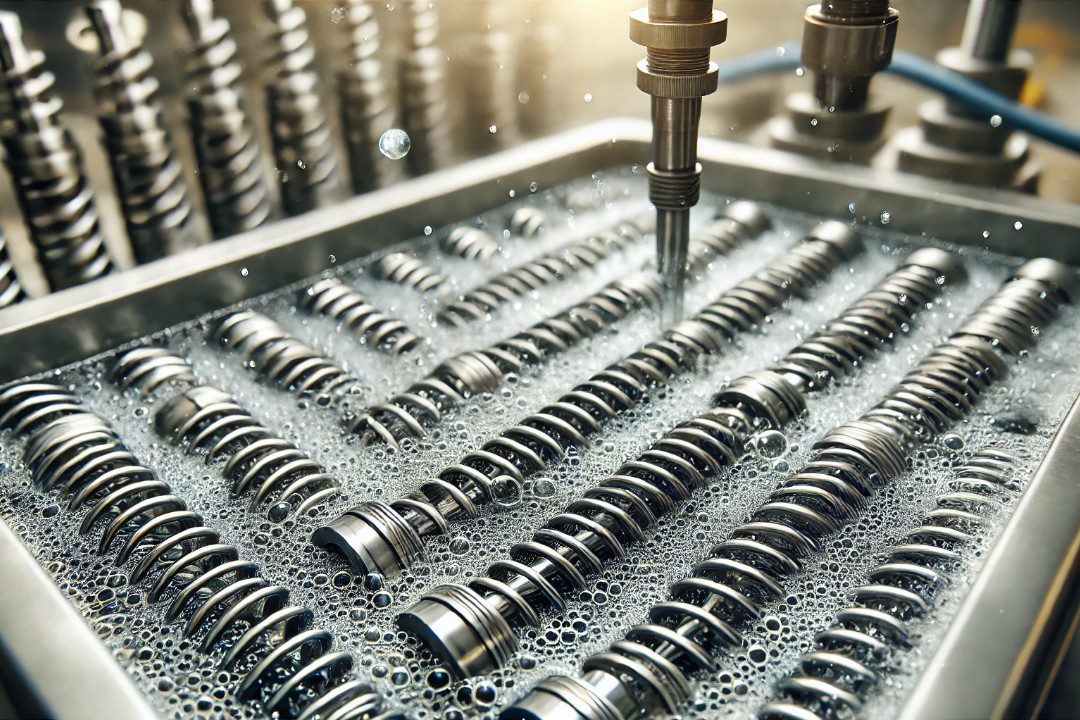Passivation is a chemical treatment process used to remove surface contaminants like iron particles and improve the corrosion resistance of metal components, including springs and wire forms.
This treatment helps form a protective oxide layer on the surface, reducing the risk of corrosion and extending the lifespan of the material.
At Western Spring Manufacturing, passivation is commonly applied to stainless steel and other corrosion-resistant alloys to enhance the longevity and performance of custom springs used in critical environments like medical devices, aerospace, and marine applications.
To explore more about the benefits of passivation in spring manufacturing, visit The Art of Crafting Precision Coil Springs and Wire Forms.
Passivation Process and Methods
The passivation process involves treating the metal surface with a mild acid solution, typically nitric or citric acid, to remove contaminants and promote the formation of a protective oxide layer. The most commonly used methods in spring and wire form manufacturing include:
- Nitric Acid Passivation: A standard passivation method where stainless steel and other alloys are immersed in nitric acid to remove surface contamination and form a passive layer. This process enhances corrosion resistance, making it suitable for springs used in harsh environments.
- Citric Acid Passivation: An eco-friendly alternative to nitric acid, citric acid passivation is gaining popularity for its reduced environmental impact. It effectively removes contaminants without the need for harsh chemicals, making it ideal for industries with strict environmental regulations.
- Electropolishing and Passivation: Electropolishing is often used in conjunction with passivation to further smooth the metal surface and enhance its corrosion resistance. The combination of electropolishing and passivation provides superior results for springs used in industries such as medical devices and food processing.
Passivation Properties and Characteristics
Passivation improves several key characteristics of metal springs and wire forms, particularly in corrosion resistance and surface cleanliness. Some of the key properties enhanced by passivation include:
- Improved Corrosion Resistance: Passivation removes free iron and other contaminants from the surface, helping form a protective oxide layer that reduces the risk of corrosion, particularly for stainless steel.
- Enhanced Surface Cleanliness: The process leaves the metal surface clean and free from contaminants, ensuring a smooth finish that reduces the potential for bacterial growth in medical or food-grade applications.
- Oxide Layer Formation: The primary function of passivation is the creation of a thin, protective oxide layer, which provides a barrier against corrosion in aggressive environments such as marine or industrial applications.
Key mechanical properties improved by passivation include:
- Corrosion Resistance: Especially effective for stainless steel and other corrosion-resistant alloys.
- Surface Cleanliness: A cleaner, smoother surface with reduced risk of contamination or bacterial growth.
- Oxide Layer: Formation of a durable, passive oxide film that extends the lifespan of the material.
Spring and Wire Form Applications
Passivation is essential for springs and wire forms used in industries where corrosion resistance and cleanliness are critical. Common applications include:
- Compression Springs: Passivated compression springs are commonly used in medical devices, aerospace systems, and industrial equipment where corrosion resistance is a priority.
- Torsion Springs: Torsion springs benefit from passivation when used in environments where they are exposed to corrosive elements, such as marine or outdoor applications.
- Wire Forms: Custom wire forms used in sensitive environments, like food processing or pharmaceuticals, rely on passivation to ensure cleanliness and prevent contamination.
Industries that commonly use passivated springs and wire forms include:
- Medical: Medical devices that require sterile environments rely on passivated springs for their corrosion resistance and cleanliness.
- Aerospace: Springs used in aerospace applications benefit from passivation, as it enhances their ability to withstand corrosive environments such as high altitudes or extreme temperatures.
- Marine: In marine environments, passivated springs are less susceptible to saltwater corrosion, ensuring longer service life.
Discover more about spring applications across industries in From Automotive to Aerospace: Applications of Springs in Different Industries.
Advantages and Limitations of Passivation
Advantages:
- Enhanced Corrosion Resistance: Passivation significantly improves the corrosion resistance of metal components by forming a protective oxide layer, particularly for stainless steel and other alloys.
- Surface Cleanliness: The process leaves the metal surface smooth and clean, reducing the potential for contamination in medical, food, or pharmaceutical applications.
- Environmentally Friendly Options: Citric acid passivation provides an eco-friendly alternative to nitric acid, reducing the environmental impact of the passivation process.
Limitations:
- Limited to Certain Materials: Passivation is most effective for stainless steel and similar alloys. Other materials may not benefit as much from this process.
- Process Costs: While beneficial, passivation adds an additional manufacturing step, which can increase the cost of production for custom springs and wire forms.
Passivation Compared with Other Treatments
While passivation focuses on improving corrosion resistance and surface cleanliness, other treatments like surface hardening and heat treating aim to improve the mechanical strength and wear resistance of the material. Passivation does not affect the strength or elasticity of the material but rather enhances its ability to resist environmental damage.
Shot peening, for example, improves the fatigue life of springs through surface compression but does not provide the same level of corrosion protection as passivation. Similarly, electropolishing can improve the surface finish but does not provide the same oxide layer that passivation does.
Passivation is often combined with other treatments to optimize both the mechanical properties and the corrosion resistance of springs used in critical applications.
Future Trends and Innovations
With the growing focus on eco-friendly manufacturing, citric acid passivation is becoming a popular alternative to traditional nitric acid methods, especially in industries where environmental impact is a concern. This method reduces the use of hazardous chemicals while maintaining the same level of corrosion protection.
Additionally, advancements in automated passivation systems are improving the consistency and efficiency of the process, allowing for more precise control over the oxide layer formation and surface cleanliness.
Learn more about the future of spring manufacturing in How Automation is Affecting the Future of Spring Manufacturing.

